Click on images to enlarge
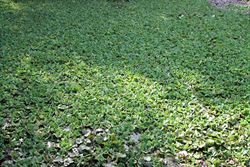
dense infestation (Photo: Sheldon Navie)

dense infestation (Photo: Sheldon Navie)

habit (Photo: Sheldon Navie)
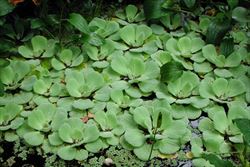
habit (Photo: Matt Taylor)
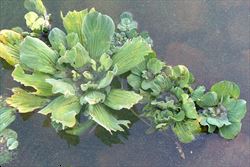
habit (Photo: Sheldon Navie)
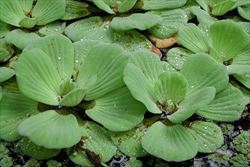
leaves (Photo: Matt Taylor)
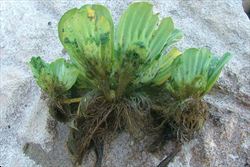
feathery roots (Photo: Sheldon Navie)
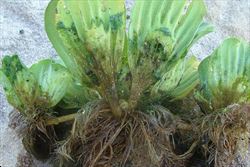
close-up of leaf undersides and stolons (Photo: Sheldon Navie)

leaves and tiny flower cluster (Photo: Land Protection, QDNRW)
Scientific Name
Pistia stratiotes L.
Family
Araceae
Common Names
floating aroid, Nile cabbage, tropical duckweed, shell flower, water cabbage, water fern, water lettuce, water lily
Origin
This species is thought to have originated in South America (i.e. in Brazil) but is now widespread throughout the tropical and sub-tropical regions of the world (i.e. it is pan-tropical). It was probably introduced into Australia from Asia.
Cultivation
Water lettuce (Pistia stratiotes) has often been grown as an ornamental in lakes, ponds, aquaria and gardens.
Naturalised Distribution
Water lettuce (Pistia stratiotes) is mainly naturalised in the coastal districts of northern and eastern Australia. It is most common in south-eastern Queensland, north-eastern New South Wales and the coastal districts of the Northern Territory. Also present in the coastal districts of northern and central Queensland, central New South Wales, and Western Australia.
Habitat
A weed of lakes, dams, ponds, irrigation channels and slow-moving waterways in tropical, sub-tropical and warmer temperate regions.
Habit
A freshwater (i.e. aquatic) plant consisting of free-floating rosettes of leaves (up to 30 cm across) with feathery roots (up to 80 cm long). Plants develops runners (i.e. stolons) and often form dense mats of vegetation on the water surface.
Distinguishing Features
- a free-floating plant forming lettuce-like rosettes up to 30 cm across.
- its feathery roots dangle below the water surface.
- the leafy rosettes produce runners up to 60 cm long, which in turn produce new rosettes.
- its fan-shaped leaves have several prominently ribbed veins on their undersides and are covered in white velvety hairs.
- separate male and female flowers are arranged in a tiny column-like flower cluster.
Stems and Leaves
The floating rosettes produce runners (i.e. stolons) from the leaf bases (i.e. axils). These runners (up to 60 cm long) are green, rounded (i.e. terete), and quite hairy (i.e. pubescent). They give rise to new rosettes and then readily detach from the parent plant.
The spongy leaves are pale yellowish-green or greyish-green in colour. These leaves (2.5-15 cm long and 2-8 cm wide) are fan-shaped or slightly spoon-shaped (i.e. spathulate) and have scalloped (i.e. crenated) margins. They have 6-15 prominent ribs (i.e. veins) on their undersides and are borne on very short leaf stalks (i.e. petioles). These leaves are arranged in an overlapping fashion on a very short stem (i.e. they are densely alternately arranged into a rosette) and are covered in soft, white, velvety hairs (i.e. they are velvety pubescent). The hairs are water repellent and trap air, thereby providing buoyancy to the plant.
Flowers and Fruit
The inconspicuous flowers lack petals and arranged on a short column-like flower clusters (10-20 mm long) arising in the leaf forks (i.e. axils). These flower clusters (i.e. spadices) have separate male and female flowers (i.e. the flowers are unisexual). A single female (i.e. pistillate) flower, consisting of an ovary and style, is found at the bottom and several (2-8) male (i.e. staminate) flowers, consisting of two stamens, are located at the top. At the base of the flower cluster is a whitish coloured bract (i.e. spathe) that is 7-12 mm long and about 5 mm wide. There is also a cup-shaped membrane on the column, which separates the male and female flowers from each other. Flowering occurs mostly during summer and early autumn.
The egg-shaped (i.e. ovoid) or oval (i.e. ellipsoid) fruit are greenish coloured berries (5-10 mm long) that contain 4-15 seeds. The mature seeds are light brown (about 2 mm long and 1 mm wide), oblong in shape, have a wrinkled (i.e. rugose) surface, and contain a small air chamber.
Reproduction and Dispersal
This plant reproduces vegetatively, by developing new plants along its runners (i.e. stolons), and also by seed.
The seeds float and are therefore most commonly dispersed by water. Entire rosettes may also be spread by water and wind movement and by boats. They are also commonly dispersed in dumped aquarium or garden waste.
Environmental Impact
Water lettuce (Pistia stratiotes) is regarded as a significant environmental weed in Queensland, New South Wales, the ACT and Western Australia. It was recently listed as a priority environmental weed in at least one Natural Resource Management region, and is also listed in the Global Invasive Species Database (GISD).
Legislation
This species is declared under legislation in the following states and territories:
- ACT: C1 - notifiable pest plant (a pest plant whose presence must be notified), and C4 - prohibited pest plant (a pest plant whose propagation and supply is prohibited).
- New South Wales: Class 1 - a state prohibited weed. The presence of the weed on land must be notified to the local control authority and the weed must be fully and continuously suppressed and destroyed (throughout the entire state).
- Northern Territory: B - growth and spread to be controlled (throughout all of the Territory), and C - not to be introduced into the Territory.
- Queensland: Class 2 - landowners must take all reasonable steps to keep land free of this species (throughout the entire state). It is also illegal to sell a declared plant or its seed in this state.
- Western Australia: P1 - trade, sale or movement into the state prevented, and P2 - to be eradicated (throughout the entire state).
Management
For information on the management of this species see the following resources:
- the Biosecurity Queensland Fact Sheet on this species, which is available online at http://www.dpi.qld.gov.au.
- the Northern Territory Department of Natural Resources, Environment and The Arts Agnote on this species, which is available online at http://www.nt.gov.au/weeds.
- the Water lettuce page on the South Coast Weeds website at http://www.esc.nsw.gov.au/Weeds/index.asp.
Similar Species
Water lettuce (Pistia stratiotes) is a very distinctive floating plant and is rarely confused with other species. Water hyacinth (Eichhornia crassipes) is another free-floating species that is slightly similar to water lettuce (Pistia stratiotes) when not in flower. It can be distinguished by its fleshy leaf stalks (i.e. inflated petioles) and by the absence of hairs on its leaves (i.e. its leaves are glabrous).

